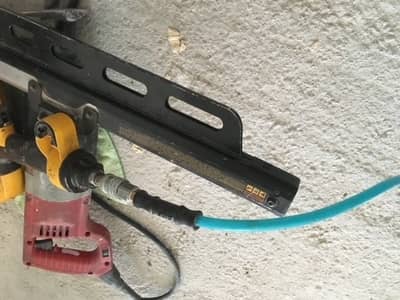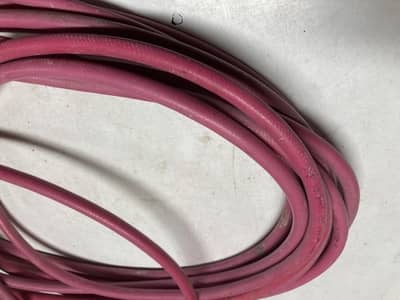Sometimes the simplest-seeming things turn out to be the most complicated. Something as simple as the air hose used with your compressor can be one of those things. There is any number of complications that can arise when deciding on an air hose for your compressor. One question that often is asked is about the hose itself and its compatibility with air compressors and tools.
Are air compressor hoses universal? Air compressor hoses are universal in their use of connecting the air compressor and tools. While hoses are universal in use, there are other variables to consider when shopping for an air compressor hose.
Home Material
Airflow and pressure loss
- Home Materials
- couplers
- Air Flow And Pressure loss
Different applications and different tools may require different styles and types of compressor air hoses. Read on to understand the requirements of the job and how air hose material, length, inside diameter, and the choice of couplings affect the delivery of compressed air to your tools Is the key to making your compressor and air hose system work together effectively.
Universal but not Equal
Most air hoses come fitted with standard size couplings and are produced to standardized inside diameter measurements. While some highly specialized environments or job requirements might call for special hose materials or fitting sizes, by and large, the air compressor hoses used in home and small shop environments are universal.
- Material
- Quality
- Price
These must all be considered when selecting an air hose for your compressor. The choice of coupling is also important to creating an efficient air supply system for your compressor and tools.
Hose Material
Rubber was once the predominant material from which air compressors’ hoses were made. Rubber air compressor hoses are still available, and some people prefer to use rubber air hoses. However, now materials used to manufacture compressor air hoses have many advantages over rubber air hoses. Five materials dominate the market in compressor air hoses.
- Rubber
- PVC
- Polyurethan
- Hybrid Polymer
- Nylon
Each of these materials has its pros and cons. Job requirements, environmental issues, and budget are the big factors in which air hose material is the best choice.
- Rubber air hoses are the old standby and are still in wide use today. Looking at the common measures of rubber air hose can give a fair understanding of where and how rubber air hoses are the best choice.
- Durability – Rubber air hoses tend to be a bit more abrasion resistant than the other materials.
- Flexibility – Rubber lies flat and doesn’t kink. This is a definite advantage around most shops.
- Weight – Rubber is the heaviest hose for its length than any of the other types. If you are lugging air hose from job site to job site, rubber air hose may not be the best choice.
- Cold Weather – If you work on outdoor job sites where the weather can become frigid, you should avoid rubber air hose. At lower temperatures, rubber air hose loses its flexibility. At extremely low temperatures, the rubber hose can become brittle.
- Price – The cost of rubber air hoses tends to fall in the middle of the spectrum. This makes them an easy choice if you aren’t expecting to use them in cold weather applications.
If you don’t need the cheapest possible hose for your compressed air system, rubber air hose is a great option. It is suitable for use in most industrial and agricultural applications. Whether you are a professional or a home/hobby user, rubber is an excellent choice. Its long life helps mediate the small bit of extra price you will pay.
2.PVC
PVC air hoses have some interesting characteristics that can be utilized to make compressed air hoses for many applications. Looking at how PVC as a material stacks up make it clear that PVC compressed air hoses may not be the best choice in many applications.
- Durability – PVC Is not as durable as rubber but better at taking abuse than polyurethane.
- Flexibility – PVC air hose tends to want to kink and coil. It never seems to relax, which can make it difficult to use in some job situations.
- Weight – PVC air compressor hose is lightweight and easy to transport. In some instances, the weight of a comparable rubber hose can be as must as four times that of the PVC counterpart.
- Cold Weather – PVC isn’t a good choice where the job site environment gets very cold. In the range of 20 degrees Fahrenheit, PVC air hose can become brittle
- Price – If you are on a strict budget, have a warm shop and don’t mind kinking and coiling, PVC is a great choice. PVC is much cheaper than rubber and comparable to polyurethane
PVC compressed air hoses are a great choice for the hobby/homeowner who needs an inexpensive air hose option to connect to a small compressor for odd jobs around the home or hobby shop. We wouldn’t suggest PVC air hose for an industrial job site or an outdoor construction work site.
3.Polyurethane
Polyurethane is the first cousin to PVC and has many of the same characteristics and traits. The tendency of polyurethane to coil tightly and to keep a memory of that coiling makes polyurethane the primary material used in self-coiling air hoses that are supplied with many small home compressors.
- Durability – Like PVC, polyurethane is not as durable as rubber. In fact, polyurethane hoses are vulnerable to many solvents used in paint shops, making them unsuitable for use in those environments.
- Flexibility – Polyurethane falls short in the flexibility category. Even less flexible than PVC, polyurethane is the choice for self-coiling hoses because of its tendency to keep a memory of the coil and to return to that position almost immediately.
- Weight – Like PVC, polyurethane is light. At about ¼ the weight of rubber air hose, it makes transporting long lengths of hose from job site to job site much easier.
- Cold Weather – It is surprising, but polyurethane has the best response to cold weather of any of the material that is used to make air compressor hoses. Typically, polyurethane doesn’t start having problems until the temperature reaches sub-zero conditions.
- Price – Air hoses made of polyurethane are probably the least expensive of the options.
If you are looking for an air hose to couple to your compressor that will be almost trouble-free, polyurethane is a good choice. The self-coiling varieties make storage a breeze and the low cost is attractive. However, if you do long lays of the airline on job sites or work where corners can be an obstacle, polyurethane air hoses are probably not a wise choice.
4.Hybrid Polymer
Hybrid Polimer has an outer rubber shield and inner nylon reinforced hose molded together with a flexible polymer binder. It is slightly lighter than a full rubber hose and resists chemicals while the inner polyurethane shell is less
- Durability – Only a full rubber hose is more durable than the hybrid.
- Flexibility – Hybrid falls short when compared to the polyurethane, but is a jack of all trades more flexible than nylon, rubber and PVC.
- Weight – only slightly lighter than rubber for the same size and length. heavier than nylon, PVC, and polyurethane.
- Cold Weather – It is not surprising, but the hybrid polymer hose has responded to cold weather fairly well. not as well as rubber or Polyurethane. but very usable.
- Price – the most expensive hose that I have purchased.
5.Nylon
nylon air hoses are inexpensive and most have replaceable/repairable ends when used in certain aspects of shops and construction they can last for years. rarely kinking and self-coiling they shin in a fixed overhead position with a blowgun or permanent tool attached for repetitive work.
- Durability – chemicals are not a nylon air hoses best friend that is why most of the time they are hung from overhead and early used in paint shops. That being said I have had some nylon hose for years hanging over workbenches.
- Flexibility – not flexible at all but that is their name to fame, nylon is hard to kink and retains a coil making ideal for quick repetitive use.
- Weight – out of all of these air hoses nylon is by far the lightest.
- Cold Weather – nylon performs poorly in cold weather, even in an unheated garage at around 40 degrees this hose starts getting stiff, and at sub-freezing temperatures its almost unusable.
- Price – the most inexpensive hose that I have purchased.
Inside Diameter, Pressure loss and Airflow
Airflow needed at the tool end of an air compressor hose can be an issue in some instances. Understanding how airflow is affected by the air hose is important when considering replacing air hose or purchasing new air hose.
- Air Hose Length – Simply put, the longer the run of air hose from the compressor to the tool, the less airflow available to the tool. There is a whole science of movement of air through hoses. Flow is affected by friction loss between the moving air and the inside surface of the air hose. The longer the length, the more the loss.
- Inside Diameter – The larger the inside diameter of the hose, the more air that can flow with less friction loss. Where job requirements or tool requirements need higher airflows, larger inside diameter hoses can be the answer.
Knowing the airflow requirements of your tools can dictate how long your air hoses should be and the inside diameter of the hose you choose. The overall goal is to size your air hose and manage your lengths so that your air compressor operates most efficiently so that you don’t risk damaging your equipment.
And then The Couplings
It is not good practice to thread the female coupling on the end of your air hose directly to the air outlet on your compressor or on your tool. This makes the whole situation inefficient. Having to unthread the coupling each time you change tools or when you want to transport your equipment from one job site to another invites damaged:
- Coupling
- Thread
- Tools
Standard practice is to install male and female quick coupling on your compressor, air hoses, and tools so that you can quickly and easily change tools, add lengths of air hose or disconnect completely for easy movement.
Couplings can induce some reduction in airflow, so it is always wise to buy the best couplings possible to ensure the airflow remains as high as possible. Good coupling should not leak at all when properly installed and fitted together. Always remember to use Teflon tape on the male threads when putting the couplings on the connections to your:
- Tools
- Air hoses
- Compressor
Putting it all Together
Getting your compressed air system together involves a lot of components. Quick connects, hose materials, hose size, and length all work together. One thing you needn’t worry about is whether the hose you choose is right for your system. By and large, the compressor air hose is universal in its applications when fitted with the right couplings and sized properly for the job requirements.







